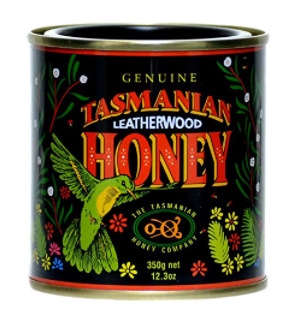honey varieties
Discover 38 Exciting Honey Varieties (#23 is Highly Sought-After)
How many types of honey varieties have you tasted?
Honey buffs like me are always eager to discover new honey varieties and understand their characteristics and nuances so as to be able to cleverly use and apply them for different food combinations. I love tasting honey, differentiating the subtle flavors among the varietals and experiencing the distinct floral varietals from the shops, online stores, direct from the farms when I travel.
Thanks to my friends, they have also brought me honey samples back from countries they visit, such as Bulgaria, Romania, Sweden, Estonia, Uganda, etc. Many varieties are somehow unavailable in this part of the world that I live in. Nevertheless, I’m still far from being an expert in honey varietals; with literally thousands of distinct varietals worldwide, and hundreds in some countries, what I’ve seen so far is only the tip of the iceberg. Discovering the different aromatic flavors of honey is an exciting never-ending journey!
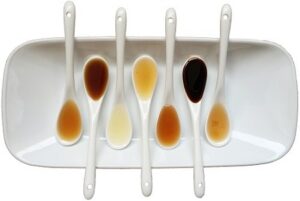
Here’s an account on some of the types of honey varieties that I have tasted and learned about (not in order of my preference but in alphabetical order):
Types of Honey Floral Varieties
1. ACACIA
Acacia, a light and clear honey made from nectar collected from the blossoms of Robinia pseudoacacia, also known as Black Locust in North America and Europe. It is one of the most popular and sweetest honey varieties because of its mild delicate floral taste. It can remain in a liquid state for a long period of time due to its high concentration of fructose. Because of its low sucrose content, it is a great choice for diabetics. Known for its therapeutic action, Acacia cleanses the liver, regulates the intestine, and is anti-inflammatory for the respiratory system.
This honey is excellent for sweetening without altering the taste or the aroma of beverages. Personally, I love to use this honey in my tea. It’s so mild that it doesn’t affect the tea’s aroma which you would want to retain. Also, kids love this honey. Its sweetness also perfectly balances the salty tang of cheese.
2. ALFALFA
Alfalfa honey, produced extensively throughout Canada and the United States from the purple or blue blossoms, is light in color with a subtle spicy profile and mildly scented floral aroma. Its delicate nature doesn’t overpower other flavors, making it a favorite choice for chefs for their baked foods and a fine table honey for tea lovers. Not as sweet as most honey types, it is a preferred choice for combining with other ingredients or enjoying straight from the jar.
3. ASTER
A distinctively sweet smelling, full bodied floral varietal, Aster honey is abundant in the Mid-South United States. It is light in color and prone to crystallize quickly. Relatively thick and smooth in consistency, this aromatic honey is a favorite choice for eating straight like a candy. My personal acquaintance with this varietal is through Really Raw Honey, which supplies beautiful Aster honey.
4. AVOCADO
Its name is a misnomer. Avocado honey tastes nothing like the fruit, avocado. Collected from the California avocado blossoms, avocado honey is dark in color and has a fairly rich and buttery flavour. This honey originated in Southern Mexico and is now a common crop in Central America, Australia and other tropical regions.
5. BASSWOOD
Produced from the cream-colored Basswood blossoms found throughout North America, Basswood honey is one of the few exceptional honey varieties that has a light color and yet strong biting flavor and a distinctive lingering flavor. It’s somewhat fresh, pleasant “woody” scent is very good with teas like Earl Grey and works well for salad dressings and marinades.
6. BEECHWOOD
Beechwood honey, also popularly known as Honeydew honey, is sourced from New Zealand’s South Island. It is an extraordinary varietal that comes from the sap produced by aphids on the bark of beechwood trees and collected by bees. An aromatic, dark amber honey, it is often mixed into smoothies, sauces, and used as sweet drizzle for pancakes and fruits. This honey is also a popular supplement for improving the body’s immunity and digestive system. Details on Beechwood honey in: Honeydew Honey – More Than The Spectacular Work of Bees.
7. BLOODWOOD
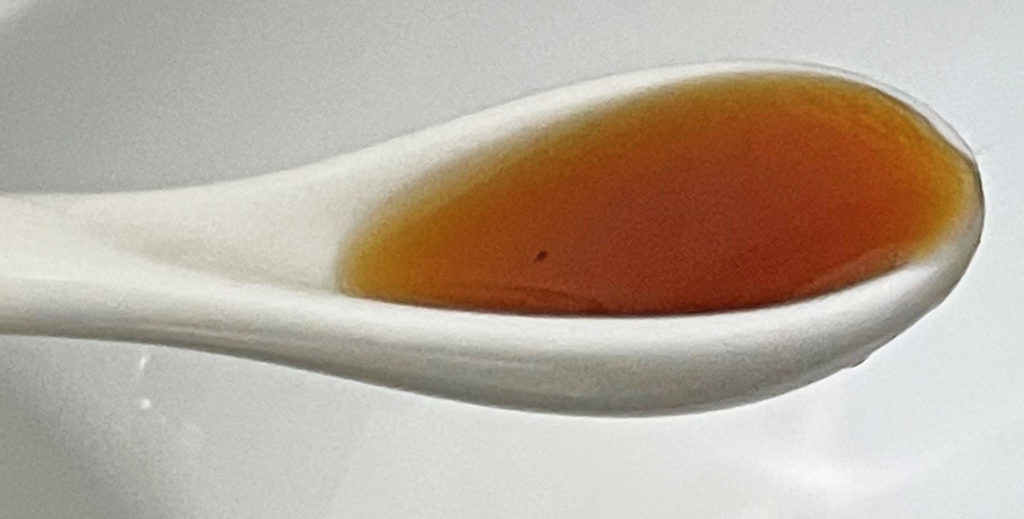
Sourced from the nectar of the Tropical Eucalypt (Corymbia gummifera) in Australia, Bloodwood is a rich, full-bodied honey with aromas of bush blossom and molasses, and unique undertones of scorched caramel. It is slow to crystallise and easy to spread on toast. It is believed that this amber colored honey has impressive healing abilities for wounds, coughs, and inflammations.
8. BLUEBERRY
Produced in New England and in Michigan, Blueberry honey is taken from the tiny white flowers of the blueberry bush. It is typically light amber in color, has a pleasant flavor, a slight tang, and a blueberry aftertaste. A good table honey.
9. BLUE GUM
Blue Gum, a Eucalyptus honey specie, grows in South Australia and Tasmania. It honey is amber in color and dense in texture. Delicious on toast and wafers, this varietal is popularly used as a breakfast or ice-cream drizzle. Blue Gum honey is a must-try for those who love the Eucalyptus range of honey. Its subtle cool, minty undertone reminds me of the blue bubble gum that kids love to chew.
10. BUCKWHEAT
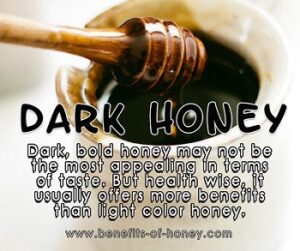
Buckwheat honey is produced in Minnesota, New York, Ohio, Pennsylvania and Wisconsin as well as in eastern Canada. It is dark, full-bodied, and rich in iron — a key reason which it’s popular with honey lovers.
Buckwheat honey has been found to contain more antioxidant compounds than some lighter honeys. It is perhaps the strongest and darkest of honey varieties. Most experts recommend using a strong-tasting type of honey, such as buckwheat for mead production. While it’s an extremely popular variety in Europe, not all Asians accustom well to its strong aroma and hence many suppliers are not too fond to import it.
More details in: Why Eat Buckwheat Honey?.
11. CHESTNUT
Made from the nectar of chestnut tree flowers, chestnut honey is one of the most popular honey varieties in Italy. It possesses a unique aroma and some of its varietals are reported to taste bitter. This amber-colour honey is mildly sweet and its low Glycemic Index makes it a honey suitable for diabetics. Get the full account in: Seriously Italian: Chestnut Honey.
12. CLOVER
Originating from Canada and New Zealand, Clover honey is one of the most widely available and popular honey varieties. Depending on the location and source, clover honey varies in color from water white to different tones of amber. White clover in particular is grown as a widespread blooming pasture crop and is a major nectar source in many parts of the world. A favorite varietal of many honey lovers (including me), this classic honey has a pleasingly mild, floral sweetness that is easily accepted. And the most distinctive characteristic of this honey for me is its lingering hint of sour aftertaste. A perfect ingredient for light sauces, salad dressings and baking!
13. DANDELION
Harvested from New Zealand’s South Island, Dandelion honey is a relatively strong honey blended with mild tangy notes. This dark amber honey delivers a distinct floral aroma of dandelions which are is traditionally prized as a medicinal herb in China, Tibet and India for its broad spectrum of powerful healing properties. Great tasting by itself, it is best eaten straight from the spoon.
14. EUCALYPTUS
Eucalyptus honey comes from one of the larger plant genera, containing over 500 distinct species and many hybrids. Its country of origin is Australia but is also produced largely in California. Widely available, it varies greatly in color and flavor but tends to have a special herbal flavor carrying a hint of menthol that may not be most pleasing to children’s palate. This honey is traditionally by many people as a protection against colds and headaches. As a tea lover, I would also recommend it as an ingredient to liven up your morning or afternoon tea. Click here for a detailed account of Eucalyptus honey.
15. FIREWEED
One of the most popular honeys, Fireweed comes from a tall perennial herb grown in the open woods of North West US. Light in color, it has its own way of being sweet and complex at the same time. It has an extraordinary smooth, delicate, and buttery taste which is great for gourmet cooking, baking, glazing, BBQ grilling, meat & fish smoking.
16. GALLBERRY
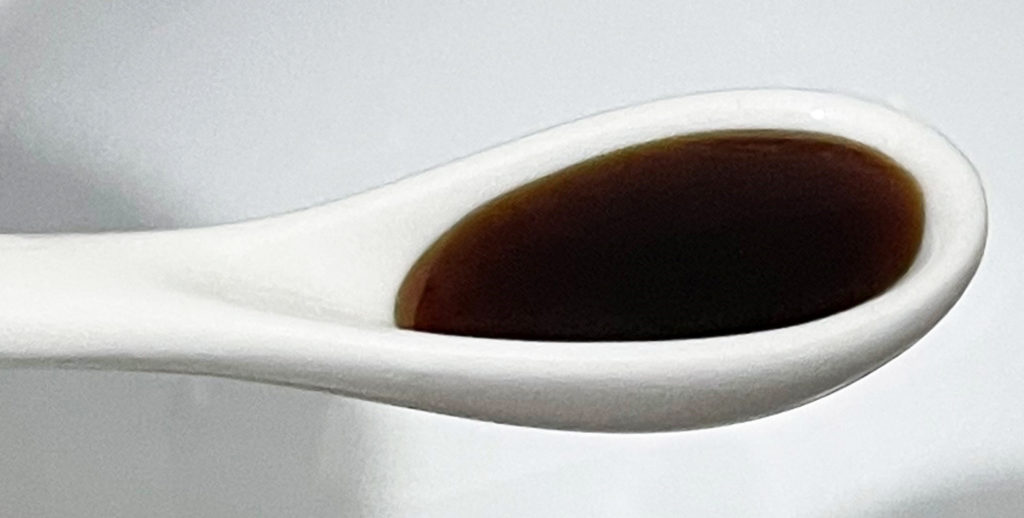
Gallberry honey is sourced from the nectar of the white inkberry blossoms and most commonly made in Florida, Georgia, and South Carolina. Amber in color, this honey is prized for its rich and aromatic flavor. It also has subtle tart citrus notes. Slow to granulate, Gallberry is a great table honey and commonly used in baking, as a meat marinate, and making honey baked ham and honey mustard.
17. HEATHER
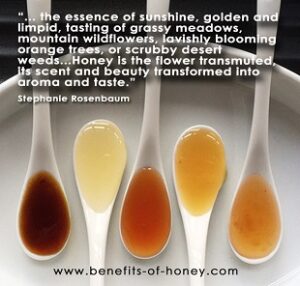
Thick, amber in color, Heather honey has one of the strongest and most pungent flavors. It is fragrant and floral with a very lingering aftertaste that is almost bitter. It is commonly served with ham, chicken, lamb, seafood and cold dishes and goes well with strong, black coffee. Prized since ancient times due to its medicinal properties, Heather honey is extremely high in protein content.
18. IRON BARK
Iron bark is a highly favored, premium Eucalyptus floral variety (Eucalyptus crebra) which blossoms throughout the year in eastern Australia. Amber in colour and dense, this honey is a favorite flavor enhancer in baking. Its slight nutty aroma makes a delicious addition to a smoothie and a good glaze for barbecued meats.
19. JARRAH
Jarrah honey (Eucalyptus Marginata) is unique to Western Australia. It is dark amber in colour and has a distinct and bolder Eucalyptus honey taste which is sometimes described as the caramel aftertaste. Jarrah honey has been much scientifically researched and found to have a higher percentage of activity level than regular honey, making it a well-known choice for treating wounds, burns and skin infections. It has been reported that some Manuka honey from New Zealand cannot even match the high activity levels of Jarrah honey.
20. LEATHERWOOD
Leatherwood honey comes from the leatherwood blossom — a native eucalypt found in the south-west of Tasmania, Australia and is the source for 70% of the country’s honey. Established worldwide as a distinct honey type and a fine gourmet product, Leatherwood honey has a unique taste and strong floral flavor. Its distinctive spicy flavor makes it an excellent spread on wheat toast, and an ideal ingredient in recipes as it not only sweetens but adds a fantastic aroma to cakes, muffins, coffee and tea. In fact, this is one of my favorite honey varieties that I find it great-tasting even when it’s just mixed with water alone. More details in: An Irreplaceable Tasmanian Honey.
21. LINDEN
The small-leaved linden tree which grows in moist, clay soil and has clusters of small, yellow-white fragrant flowers hanging from slender stems, is common throughout Denmark. It’s planted in gardens, parks and along road sides, city streets and boulevards.
Linden honey is one of those honey varieties that will completely change the misconception of those who think that honey is no more than just sugared water. It has a light yellow color and a very distinctive yet delicate fresh woody scent. Because of its sedative and antiseptic qualities, it’s one of my favorite honey varieties before bedtime. It is recommended in cases of anxiety and insomnia, whereby honey can be combined with a bath of linden blossoms before sleep. Linden honey is also used in the treatment of colds, cough and bronchitis.
22. MACADAMIA
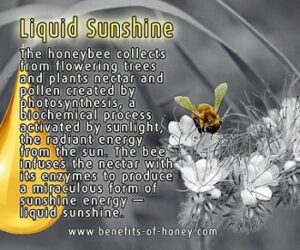
Sourced from the floral nectar of the Macadamia Nut tree, Macadamia Honey first originated in Australia and today is also supplied from the United States. This deeply coloured honey variety possesses a distinctive, complex aroma and a subtle nutty flavor that goes extremely well with fruit and vegetable salads, ice-cream, toasts and herbal tea, and is a scrumptious marinate or glaze for grilled chicken wings as well.
23. MANUKA
Found only in New Zealand’s costal areas, Manuka honey is collected from the flower of the Tea Tree bush. The Unique Manuka Factor (UMF) found in some Manuka honey is an antibacterial property which is especially effective for healing of stomach ulcer, sore throats, colds, indigestion, acne and pimples. Some people find Manuka honey too “medicinal” in taste but as mentioned, the intensity can vary from brand to brand due to the difference in source. Personally I love its robust taste – the best is to eat it direct straight from the spoon! More in: The Miraculous Manuka Honey.
24. NEEM
Bitter-tasting Neem honey is produced from the nectar source of Neem (also known as Margosa Tree) flowers which are common in warm tropical countries like India. Highly valued in Ayurveda for its medicinal properties, Neem honey is known to be effective in lowering high blood pressure, treating diabetes, skin problems, dental diseases, infected throat, and allergies.
25. ORANGE BLOSSOM
Orange blossom honey, often a combination of citrus sources, is usually light in color and mild in flavor with a fresh fruity scent, and a fragrant citrus taste. Orange blossom honey originated from Spain/ Mexico but is produced in many countries including Florida, Southern California and Texas.
26. PUMPKIN BLOSSOM
From the natural nectars of the Pumpkin Blossoms and harvested once a year in the early fall, Pumpkin Blossom honey is a dark amber-colored liquid with a light floral fragrance. As a specialty gourmet varietal, it is an incredibly suitable topping for dishes and desserts and works well when paired with savory or spicy ingredients, like a barbeque sauce. When drizzled on sweet potatoes, yogurt and desserts, it also tastes great. Contrary to what its name suggests, Pumpkin honey does not taste like Pumpkin Pie at all.
This honey is seasonal and limited as the bloom is short and does not produce much nectar. It’s hard to find it in my country, but whenever I could lay my hands on it, I like to use it to replace sugar in my bread-making.
27 RAINFOREST
This honey variety has a full body and a light fresh, floral aroma, but the its taste can vary a great deal depending on the source of nectar – for instance it could originate from the rainforest trees of Brazil, Australia, Tasmania, Thailand, the US, etc. One of the most favorite floral varieties among the children, it is often used as a breakfast jam or mixed into a honey drink. It is popularly used in cooking and baking and hailed as an excellent sauce ingredient.
28. RATA
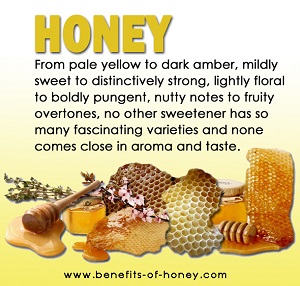
Produced from the West coast of New Zealand’s South Island, Rata honey is a light color, buttery smooth varietal that has impressed many serious honey enthusiasts. It has a mild, subtle taste and yet very memorable, pleasantly sweet aroma. Rata honey has a relatively high glucose content. It crystallizes quickly and thus is usually processed into a cream honey. When mixed with water, it makes an absolutely delicious, soothing tonic with a fruity hint.
29. RED GUM
Red Gum is a common Eucalypt found in Australia that produces one of the darker premium varieties of honey. Having a relatively higher level of antioxidants compared to the rest, red gum honey has a thick constituency, a bold taste (like buckwheat honey) and a distinctive aroma which I believe fans of strong honey varieties would find it appealing. It’s also a favorite ingredient in bread baking and meat marinades.
30. REWAREWA
Full bodied and malty, Rewarewa honey comes from a bright red needle-like flowers grown in the bushy hills and valleys of New Zealand. It’s one of the first floral varieties that I tried when I started exploring honey. This classic dark red premium honey possesses a caramel-like and slightly burnt flavor that makes it popular natural sweetener for hot drinks and a spread. It is ideal for both sweet and savory dishes and is well-known for use in oriental dishes.
31. PINE TREE
Pine Tree honey (sometimes also known as forest honey, fir honey, honeydew or tea tree honey) consists of the majority of the total honey production in Greece. It is not particularly sweet, tastes a little bitter, has a strong aroma, and is relatively rich in minerals and proteins. It is rather resistant to crystallization.
32. SOURWOOD
Some claim that this honey is sour. However, contrary to its name, many have also reported that sourwood honey is not sour, but sweet like any honey. This light-colored, delicate, subtle honey has an almost caramel or buttery flavor, and a pleasant, lingering aftertaste. With this honey, you don’t need any more butter on your biscuits or bread!
33. SAGE
Sage Honey, primarily produced in California, is light in color, heavy bodied and has a mild but delightful flavor. It is extremely slow to granulate, making it a favorite honey variety among honey packers for blending with other honeys to slow down granulation.
34. TAWARI
Originating from the creamy white flowers of New Zealand’s Tawari trees, this honey has a golden color and a creamy butterscotch flavor. So subtle and mild, it’s a perfect chef choice for topping desserts such as pancakes, waffles or ice-cream.
35. TUALANG
Made by the aggressive giant honey bees, Apis dorsata which are about twice the size of the European honey bees, Malaysia’s Tualang honey is a famous health tonic and medicine. The locals use it to heal wounds, skin infections, flu, and regulate blood sugar and lower blood pressure. Its antibacterial potency against wound and enteric micro-organisms is believed to be comparable to New Zealand’s Manuka honey. More details in: Probably Malaysia’s #1 Honey – Tualang Honey.
36. TUPELO
Named as the “champagne of honeys”, “Queen of honey”, “Southern Gold”, Tupelo honey is a premium honey produced in the Southeastern U.S. swamps. It is usually light golden amber with a faint greenish glow, and has a mild, distinctive taste. Because of its high fructose content, Tupelo honey is one of the sweetest honey varieties and it hardly granulates. More details in: Tupelo Honey – Queen of Honey.
37. WILDFLOWER
Also known as “multiflora” or “mixed floral” honey, Wildflower is often used to describe honey varieties from miscellaneous and undefined flower sources. Its color can vary from very light to dark and flavor range from light and fruity to tangy and rich, depending on the mix from the different seasonal wildflowers.
38. YELLOW BOX
Yet another eucalyptus bush variety (Eucalyptus melliodora) native to Australia, yellow box honey is one of the most highly regarded honey in the country (in terms of taste). Its smooth texture, heavy-bodied yet mild Eucalyptus blend also make it a popular choice for adding to tea and coffee, baking and a perfect drizzle for puffs, cakes and bread. This honey is slow to granulate.
Other Related Articles on Honey Types
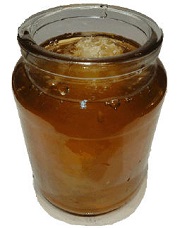
1) If you are located in Singapore, you can now buy from us the different types of honey such as Yellow Box, Eucalyptus, Wildflower, Rainforest, Manuka, Macadamia, and Leatherwood: Buy Honey Online.
2) Dark bold honey may not be appealing to everyone in terms of taste. But health wise, it could be a more popular choice than light color honeys. More in: Dark Honey Boasts High Antioxidants.
3) If you think honey tastes horrible, don’t give it up because there are so many floral varieties that it’s impossible not to find something that can please your taste buds. Read: Taste Honey? No Way!
4) Ever wonder which types of honey varieties to buy so as to go with the kind of food you are preparing for the day? Click here to find out about the Uses of Honey Varieties in Cooking.
5) What is Cactus Honey Powder? Claimed to be all natural, cactus honey powder is marketed as all natural, healthy to eat, and an excellent sugar replacement suitable for the diabetic. And it’s positioned as a brilliant ingredient for baking or drizzled on cereals, pancakes and waffles. However, what’s the origin of this powder? Does it come from the bees? Find the answer in Who Says Cactus Honey Powder is Honey!
6) It is believed that organic honey is a healthier choice as it’s tested to be free of pesticides or environmental pollutants. Some even claimed that it tastes better than conventionally produced honey. Read What Makes Organic Honey Different?
7) Ever eaten milky or white honey, or even heard about it or seen it before? Read Is Indonesia’s White Honey Real?
8) Pineapple honey and durian honey, two very unique mono-floral honey from Malaysia. More in: Truly Unique Honey from Malaysia.
9) Ever tried stingless bees’ honey? Read: Stingless Bees are an Eye Opener.
10) Honeydew honey is the amazing combined work of two insects and is exceptional in its health benefits. Find out what this extraordinary honey is: Honeydew Honey – More Than The Spectacular Work of Bees.
11) What is wild honey? Is it more superior than cultivated honey? More in: Puzzling Wild Honey Questions. Need Your Help!.
12) Why are honey sticks so popular? More in: Happy Treats of Honey Sticks.
13) Only when you bite into a piece of honeycomb and taste the honey in it, you will probably never understand: Why You Must Experience the Taste of Honeycomb.
14). A question that many are asking: Do You Eat Honey From China?
